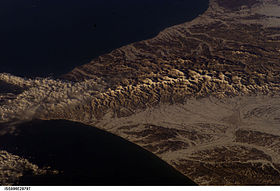Hidaka Mountains
| Hidaka Mountains | |
|---|---|

Mountains, taken from the ISS on Feb. 22, 2003
|
|
| Highest point | |
| Peak | Mount Poroshiri |
| Elevation | 2,052.4 m (6,734 ft) |
| Coordinates | 42°43′9″N 142°40′58″E / 42.71917°N 142.68278°E |
| Dimensions | |
| Length | 150 km (93 mi) north to south |
| Naming | |
| Etymology | sun high |
| Native name | 日高山脈 Hidaka-sanmyaku |
| Geography | |
| Country | Japan |
| State | Hokkaidō |
| Regions | Hidaka Subprefecture and Tokachi Subprefecture |
| Districts |
List
|
| Range coordinates | 43°09′N 142°59′E / 43.15°N 142.99°ECoordinates: 43°09′N 142°59′E / 43.15°N 142.99°E |
| Biome | alpine climate |
| Geology | |
| Age of rock | late Quaternary |
| Type of rock | Fold (geology) |
Hidaka Mountains (日高山脈 Hidaka-sanmyaku?) is a mountain range in southeastern Hokkaido, Japan. It runs 150 km from Mount Sahoro or Karikachi Pass in central Hokkaidō south, running into the sea at Cape Erimo. It consists of folded mountains that range from 1500 to 2000 metres in height. Mount Poroshiri is the highest at 2052 m. The Hidaka Mountains separate the subprefectures of Hidaka and Tokachi. Most of the range lies in the Hidaka-sanmyaku Erimo Quasi-National Park (日高山脈襟裳国定公園, Hidaka-sanmyaku Erimo Kokutei-kōen). Since the mountain range lies so far north, the alpine climate zone lies at a lower altitude.
The Hidaka Mountains formed in the late Quaternary as part of the outer arc of the western end of the Kuril island arc. They were formed by the uplift resulting from the collision with the Kuril arc and the Northeast Japan Arc. The Hidaka mountains no longer appear to be uplifting.
The western end of the range is high P/T metamorphoseed Jurassic accretionary complex as part of the Kamuikotan belt. This is characterized by sedimentary rocks from the Cretaceous and Jurassic-Lower Cretaceous periods. The eastern end of the range is tertiary metamorphic rock as part of the Hidaka Metamorphic belt. This is characterized by low to medium pressure metamorphic rocks with sedimentary rocks from the Cretaceous-Lower Miocene. Plutonic rocks intrude into these structures. For the most part, the Hidaka mountains are composed of schists, migmatites, gneisses, and granites.
...
Wikipedia
